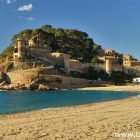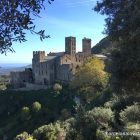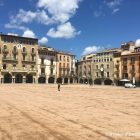
Ripoll is a small town in the foothills of the Pyrenees mountain range, one hundred kilometres from Barcelona. The town is best known for the monastery of Santa Maria de Ripoll, which was founded in the ninth century and is considered one of the most important Romanesque monuments in Spain.
Ripoll also makes a good base for exploring the surrounding area, which is dotted with picturesque villages and is popular among walkers, cyclists and climbers. In winter, you can ski or snowboard nearby at the Vallter 2000 ski resort.
What to see and do in Ripoll
Monastery of Santa Maria de Ripoll
The Monastery of Santa Maria de Ripoll was founded in 879 by Wilfred the Hairy as part of his efforts to repopulate the area surrounding Vic and Olot, which was a no man’s land that separated Christian and Muslim-controlled territories.
By the eleventh century, the monastery had become one of the most important religious centres in the Iberian Peninsula, with a scriptorium where monks produced illuminated manuscripts and bibles.
The building was badly damaged by an earthquake during the fourteenth century and repeated wars before being reduced to ruins during the First Carlist War. The monastery was rebuilt and restored during the nineteenth century.
Today, the main points of interest are the elaborately carved twelfth-century portico, the two-storey cloisters and the tombs of the Catalan Counts.
Opening times
April – September
Monday – Saturday 10:00 – 14:00, 16:00 – 19:00
Sunday 10:00 – 14:00
October – March
Monday – Saturday 10:00 – 13:30, 15:30 – 18:00
Sunday 10:00 – 14:00
Public holidays CLOSED
Antrance Fee
Adults €7.50
Children & Seniors €5.50
More information here.
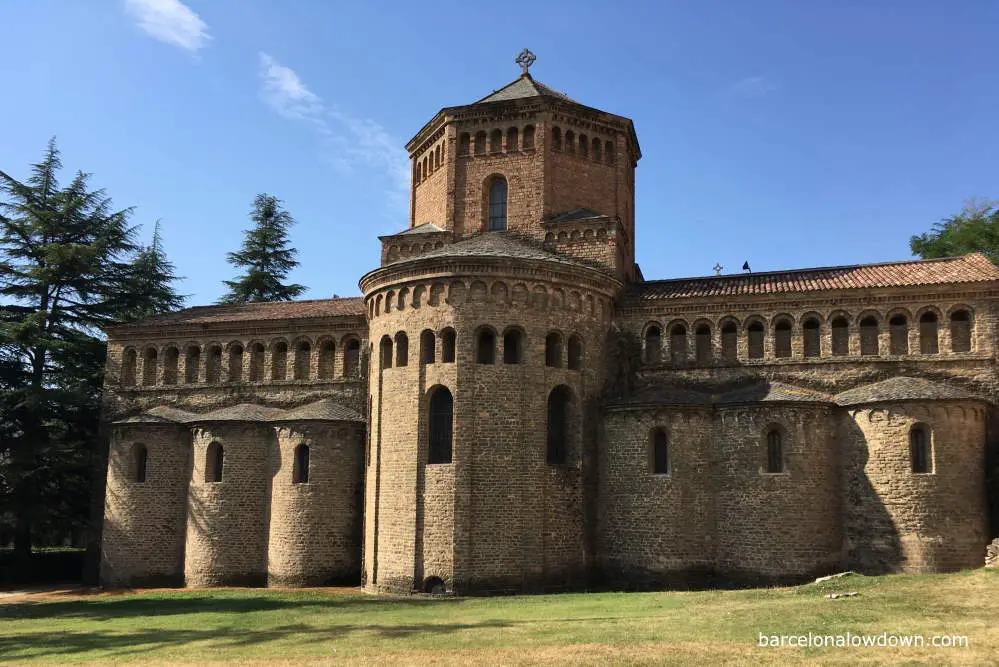
The old town
From its foundation during the Middle Ages, Ripoll was a walled town that grew up around the monastery. As mentioned above, the walls, monastery and most of the other buildings were reduced to rubble at the start of the nineteenth century.
Ripoll Tourist Office has published a walking route that traces the medieval walls. The remains of the walls and medieval buildings are marked with signs in four languages (Catalan, Spanish, English and French).
Some of the signs also have QR codes which link to the tourist office website with further information.
Romanesque and Modernista architecture
Two styles of architecture stand out in Ripoll. Romanesque, from the Middle Ages and Modernista, the architectural style favoured by wealthy industrialists during the late nineteenth and early twentieth century.
Once again, the tourist office has created a walking rout the takes you to the town’s most notable buildings.
You can pick up free maps of both walking routes plus leaflets with information about the monastery, Ripoll and the surrounding area at the tourist office, which is located next to the monastery.
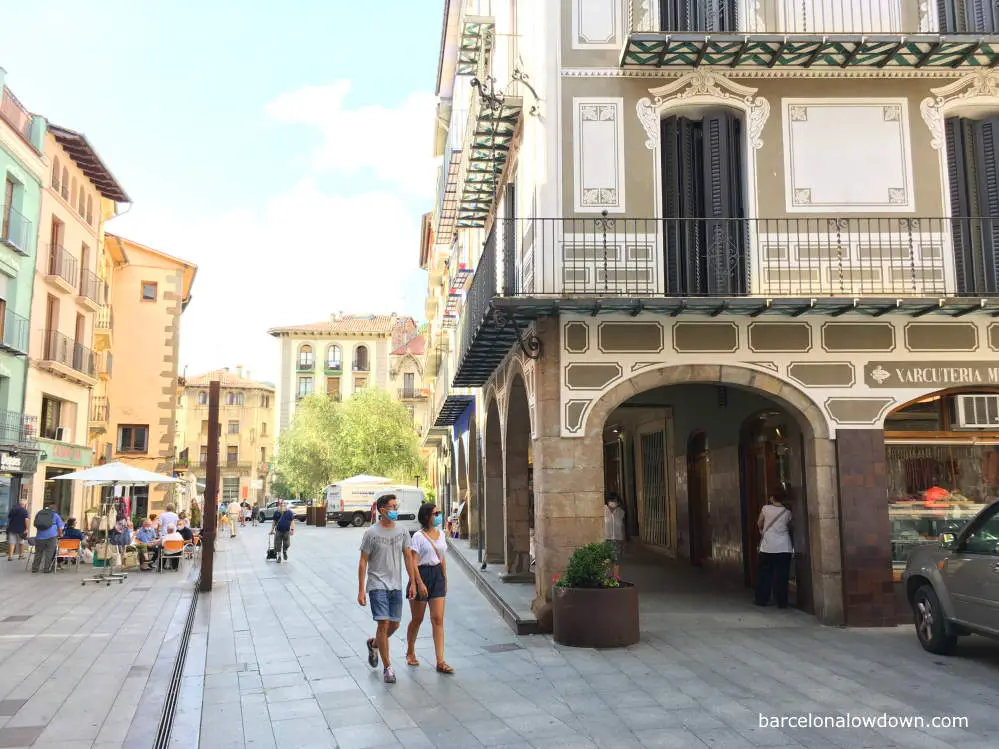
La Ruta del Ferro i del Carbó (Iron and Coal Route)
Ripoll was once home to a thriving metalworking industry using coal and iron ore that was extracted from mines in the mountains which surround the town. During the nineteenth century, a train line was built to transport coal from the nearby town of Ogassa.
The mines at Ogassa stopped operating during the 1960s and the train line closed approximately ten years later. The route of the old train line is now part of a network of so-called Green Ways (Vies Verdes) that have been converted into cycle paths.
From Ripoll to Ogassa is approximately fifteen kilometres. Alternatively, if you are walking, you can choose to stop at Sant Joan de les Abadesses, nine kilometres from Ripoll. In the summer there are several buses per day from Sant Joan de les Abadesses back to Ripoll. Timetables here.
The path starts from a car park on the outskirts of Ripoll (see map below) where there is a small bar-restaurant and a cycle rental shop where you can hire mountain bikes and e-bikes. To avoid disappointment, you should reserve bikes in advance via their website here.
The route is well maintained and is suitable for cyclists and walkers of all ages and experience. At the weekend, it is a popular choice among families as well as more serious cyclists.

For the first kilometre and a half, the cycle path runs roughly parallel to the C-26 highway before breaking off into the countryside. Along the way, you pass remnants of the old railway, including several old brick tunnels and bridges.
If you’ll be bringing your bicycle with you on the train from Barcelona, one of the wagons (normally near the middle of the train) has space for storing two bikes. Officially only two bikes are permitted per train. In practice, as long as the train isn’t overcrowded, more bikes are allowed to board.
Map of the route here.
More information about the greenways here.
This short video from YouTube will give you a good idea of what the route is like.
Ripoll Ethnographic Museum
The Ripoll Ethnographic Museum traces the development of the region. The museum occupies three floors with collections related to farming, rural life and the iron industry.
The museum is quite small, and I was surprised when I realised that we spent about forty-five minutes there. Displays are only labelled in Catalan so if you haven’t done so already, it might be a good idea to install a translation app on your phone.
Opening times
Tuesday – Saturday 10:00 – 13:30, 16:00 – 18:00
Sunday 10:00 – 14:00
Monday CLOSED (except August)
Antrance Fee
Adults €4
Children & Seniors €3
Last Sunday of the month FREE
More information here.

Scriptorium
Throughout the Middle Ages, monks from the Monastery of Santamaria de Ripoll produced bibles and manuscripts that were exported throughout Europe. The museum contains exhibits explaining the history of the scriptorium and how manuscripts were produced.
Guided tours of the Scriptorium take place several times a week.
Adults €3
Children & Seniors €1.50
La Farga Palau
The Farga is a seventeenth-century forge with large hammers powered by a waterwheel using water from the River Freser. Prior to the Industrial Revolution, Ripoll was a major centre for iron production and the forge continued to produce copper items until it closed in 1978.
Guided tours of La Fraga take place several times per month.
Adults €5
Children under 12 FREE
Information about tours of the Scriptorium and Farga here.
Brief history of Ripoll
Located at the intersection of the rivers Freser and Ter, Ripoll is often referred to as The Cradle of Catalonia thanks to its religious and cultural importance during the Middle Ages.
The town was founded during the ninth century when Count Wilfred the Hairy built the Santa Maria de Ripoll monastery here in 879 AD. As the Benedictine monastery flourished during the eleventh century, the walled town of Ripoll grew up around it. In addition to the monastery, during the Middle Ages, Ripoll developed a flourishing metalworking industry producing nails, crossbows and later rifles.
During the seventeenth and eighteenth century, Ripoll was ravaged by wars and both the monastery and surrounding buildings were all but destroyed.
During the nineteenth century, the town once again prospered thanks to its plentiful water supply which made it an ideal location for several large textile mills.
Today, Ripoll has a population of around eleven thousand people. With good connections by train and road from Barcelona, it’s an attractive stopping off point on the way north to the Pyrenees.
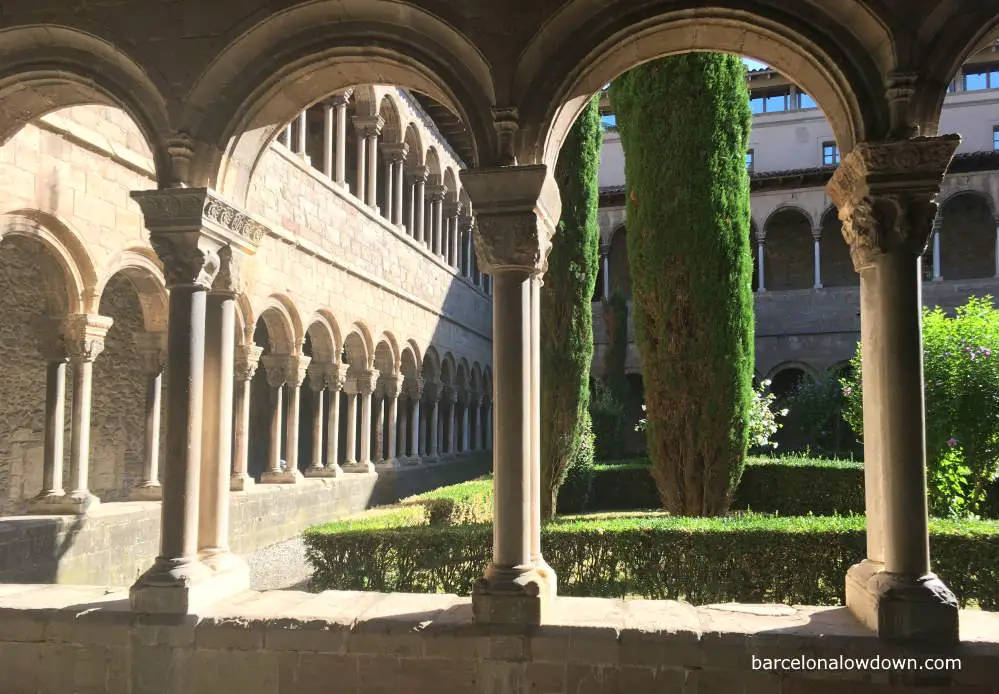
Ripoll festivals and events
National Wool Festival and Farmer’s Wedding
This curious local fiesta called La Festa Nacional de la Llana i Casament a Pagès takes place in May in front of the town hall. The fair is a celebration of rural life and includes displays of traditional music and dance as well as giants processions and the recreation of a traditional country wedding. More information here.
Festa Major
Like most Catalan towns, Ripoll stages an annual fiesta complete with processions, fire runs and human towers. The Festa Major de Sant Eudald takes place during May.
International Music Festival
Ripoll’s annual music festival takes place during August with concerts and recitals staged and the Monastery de Santa Maria de Ripoll. Musical styles include Jazz, classical and Gregorian chant. More information about the event and this years schedule here.
Medieval Market
In August the town stages its annual Medieval fair, El Mercadal del Comte Guifré. The fair, which celebrates the life of Count Wilfred the Hairy, features stalls selling handicrafts and locally produced foodstuffs as well as jousting, archery tournaments and theatricalised tours of the Medieval town centre.
Ripoll Cheese Festival
In September cheese lovers get the chance to sample and purchase a range of locally produced artisan cheeses at the International Cheese Festival.
Catalan Sheep Festival
The Fira de Santa Teresa i Fira Catalana de l’Ovella is a small scale agricultural fair which takes place in October.
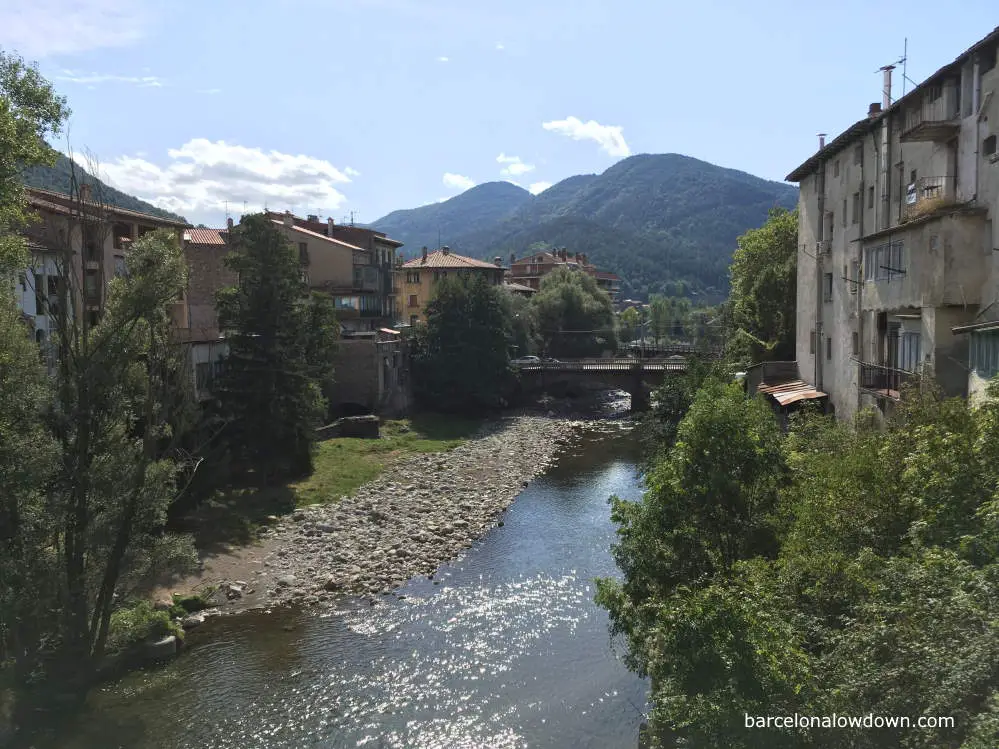
Where to stay in Ripoll
We stayed at La Trobada Hotel Ripoll which is a modern hotel located just outside the historic town centre. The hotel is clean and comfortable and within easy walking distance of both the town centre and the train & bus stations.
If you are looking for something more rustic, there are holiday cottages and apartments available in Ripoll and the surrounding area some of which are traditional farmhouses.
How to get to Ripoll from Barcelona
By car
Ripoll is located approximately 100km from Barcelona and it takes about an hour and a half to get there following the C17 highway.
If you will be completing the La Ruta del Ferro i del Carbó there’s a large car park at the start of the trail (see map).
By train
There are frequent trains from Barcelona to Ripoll. The train takes approximately two hours and the station is a ten-minute walk from the town centre. If you are travelling with bikes, there is normally a carriage with dedicated bike storage near the middle of the train. Check timetables and fares here. For the best views, you should sit on the left-hand side of the train when travelling to Ripoll.
By bus
Bus company Teisa run six buses daily between Barcelona and Ripoll. Check timetables here. The bus station is next to the train station.

Places to visit and things to do near Ripoll
Hiking trails
Ripoll is located in the foothills of the Pyrenees mountain range in an area called El Ripollès. The area is popular with walkers and climbers and you can pick up a map of local hiking trails, graded by difficulty at the town’s tourist information office.
There is more information online at the Itinerannia website here. Itinerannia has also created a useful app which is available in English for both Android and iOS operating systems.
You can also find information about most of the routes on Wikiloc here.
Ribes de Freser
Ribes de Freser is a lively mountain village fourteen kilometres north of Ripoll. A popular summer destination among Barcelona residents who come to escape the heat, it’s also the hopping off point for the rack railway to the Vall de Nuria. In addition the picturesque surroundings, the village boasts an eleventh-century Romanesque church and the ruins of a medieval castle.
Vall de Nuria
Set as an altitude of almost two thousand metres, the Vall de Nuria is renowned as the most beautiful valley in the Catalan Pyrenees. The valley can only be accessed on foot or by taking the rack railway, making it an ideal place to escape the traffic and bustle of Barcelona. Hardly surprisingly, the valley and surrounding peaks offer countless options for walkers and climbers. Other activities include horseback riding, canoeing and skiing.
Girona
A deservedly popular day trip from Barcelona, Girona boasts one of the largest and best-preserved Jewish quarters in Europe. The walled city centre is a maze of narrow cobbled streets and imposing medieval buildings which were featured in series six of Game of Thrones.
Vic
Halfway between Barcelona and Ripoll, Vic is best known for having the largest arcaded square in Catalunya, a rich medieval heritage and for the production of Fuet, a type of cured sausage.
You can pick up a map from the Tourist Office with a walking route that takes you to the most important sights including the Roman Temple, medieval cathedral and the excellent Episcopal Museum that contains a large collection of Romanesque art.
In December the town hosts a popular medieval fayre.
Map
Zoom in to see the location of the places mentioned in this post.
Ronda de Mas d'en Bosch, Ripoll.
Passeig del Compositor Honorat Vilamanyà, 4, Ripoll
Carrer del Progrés, Ripoll
Carrer del Progrés, 49, Ripoll
Passeig de la Farga Catalana, 16, Ripoll
Plaça de L'abat Oliba, 2, Ripoll, Girona
Passeig del Compositor Honorat Vilamanyà, 3, Ripoll
Plaça de L'abat Oliba, s/n, Ripoll


